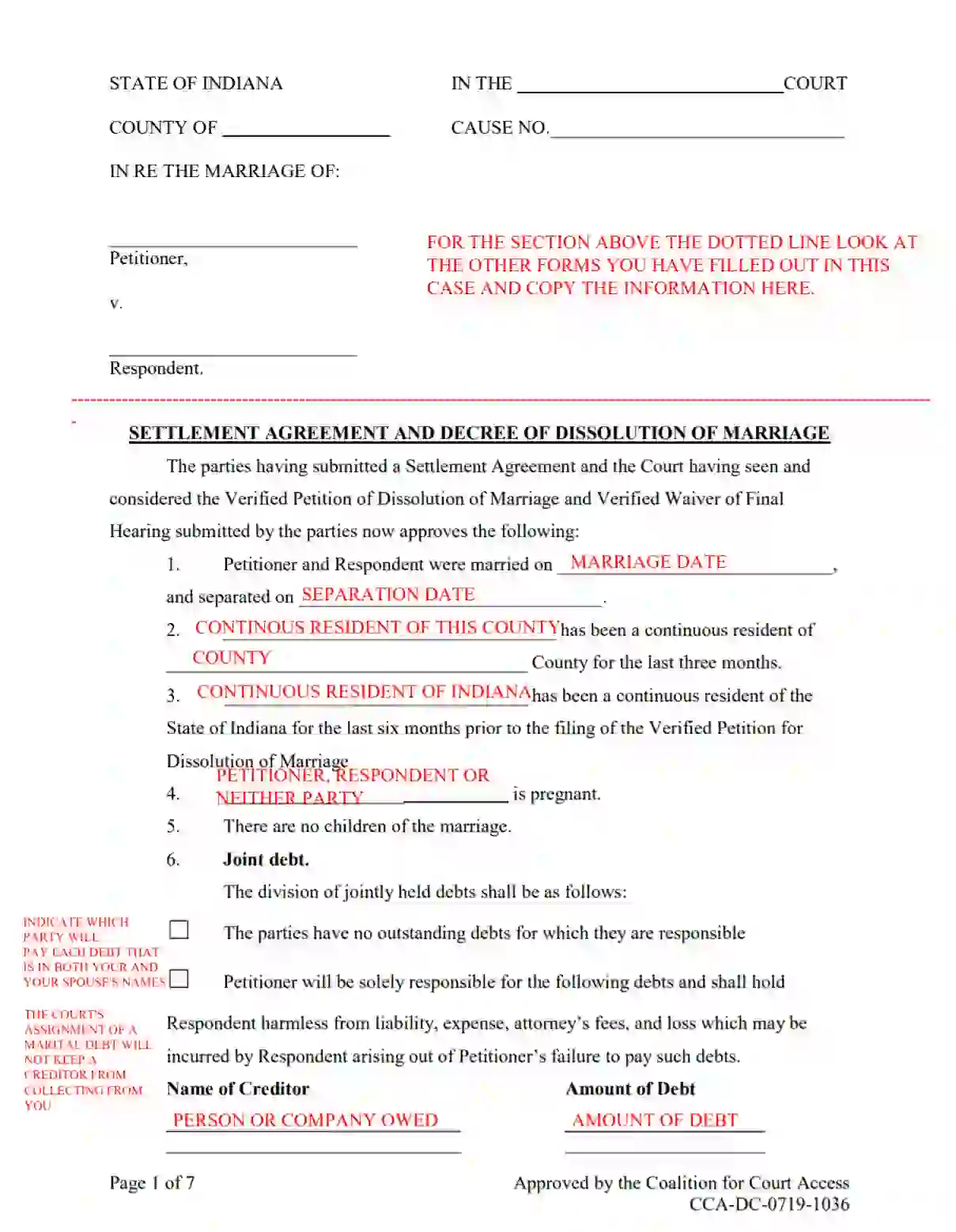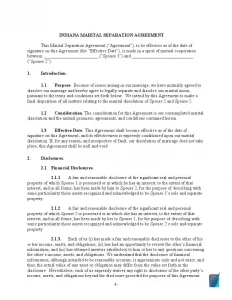Indiana Marital Settlement (Divorce) Agreement and Legal Separation
Life is full of unexpected situations. Unfortunately, your life partner can turn out to be the wrong person. Divorce is a legal process that finalizes your relationship with that person. In every American state, you have to go through a time-consuming and exhaustive procedure and prepare a great deal of paperwork to get the job done. Each state has passed laws to regulate the process and make every aspect clear to people who apply for a divorce. However, American residents still have a lot of questions on the topic. Thus, in this article, we will try to clarify some divorce issues.
First, the divorce procedure can be less painful if you reach a mutual agreement with your partner. Once you have done this, record all your terms and conditions in a Marital Settlement Agreement (MSA). It is a legal document that establishes rules and responsibilities regarding child support, guardianship, division of property, debt distribution, etc. If you want to include a topic not covered in the fillable marital settlement agreement template, we recommend seeking legal advice.

Build Your Document
Answer a few simple questions to make your document in minutes
Save and Print
Save progress and finish on any device, download and print anytime
Sign and Use
Your valid, lawyer-approved document is ready
Indiana Divorce and Separation Laws
In Indiana, the entire process and all matters related to divorce are regulated by Article 15, Title 31 of the Indiana Code. The Indiana General Assembly official website gives you access to all articles and sections of the title.
Grounds for Divorce
Indiana recognizes both no-fault and fault grounds for marriage termination. According to Section 31-15-2-3, you can initiate divorce for these four reasons:
- Irretrievable marriage failure (it is considered to be no-fault)
- Felony conviction
- Severe mental illness for at least two years
- Impotence
Property Division
Section 31-15-7-5 of the Indiana Code is devoted to property splitting matters. Unlike states that have enforced community property law, Indiana uses the police of fair distribution rather than divides assets equitably. Indiana courts consider many factors—from the partners’ personal contributions to their conduct during the marriage—some of which may prove that equal division is not fair.
Child Custody and Visitation
Child custody provisions are stated in Section 31-17-2-8. These statutes protect children’s rights and interests. Indiana courts encourage divorced partners to communicate and cooperate so that the child could see both parents after the divorce. Joint custody is more favorable as it prevents the child from experiencing deep psychological trauma. If one of the parents puts the child’s life and mental health at risk, joint custody cannot be granted.
As for visitations, Indiana courts make decisions based on the best child’s interests and allow the non-custodial parent to have private moments with their child but recommend informing the other party about a change in the visitation schedule.
Child Support and Alimony
If you need to get detailed information on this matter, check out Section 31-16-3-1. Before deciding on child support, the judge considers many factors—the child’s financial and educational needs, both parents’ financial abilities, the parents’ and child’s age, and mental and physical health conditions, among other things. Child support means any future expenditures on medical and educational needs.
Alimony (also known as spousal maintenance) issue in Indiana is regulated by Section 31-15-7-2. The court can oblige one of the partners to support the other financially. The primary reason for granting alimony is that either spouse’s lifestyle has undergone drastic changes after the divorce, leading to failure to maintain themselves sufficiently. The inability to support their basic needs can be caused by quitting their current job to take care of the child or lack of mental or physical abilities.
Popular Local Marital Settlement Agreement Forms
A marital settlement agreement, also known as a mediated separation agreement, is a powerful document that might help you settle the divorce and eliminate undesired stress. Listed here are the states the residents of which search for this template the most.
Legal Separation
Legal separation differs from divorce. It is filed for when people want to live independently without formally ending their marital relationships. In Indiana, the primary ground for such separation is intolerable conditions preventing the couple from having a normal life together.
This situation is often regarded as a cool-off period (in Indiana, it cannot exceed one year) in a marital relationship. During a legal separation, the couple can choose to get back together or decide to divorce.

Filing for Divorce in Indiana
Understanding the divorce process is crucial. When all the things are clear to you, you are unlikely to have an emotional breakdown caused by the complex and time-consuming procedure. We hope that the guide below will prevent you from making mistakes and clarify any ambiguities.
The first thing that is worth mentioning is the place where you submit all divorce papers. In Indiana, one of the superior court divisions or a circuit court deals with family matters. Before filing the documents, find a court that is likely to accept your papers. You can do it by visiting the Indiana Judiciary’s official website and downloading the Directory of Courts and Clerks, which provides the addresses and contact information of all courts and clerk offices located in all Indiana counties. Find your county in the list and contact the clerk for answers to all your questions.
Once you have found the court responsible for handling divorce cases, find out how much money you need as filing fees to prepare the required amount in advance. In Indiana, the filing fee varies from court to court, but it is approximately $152.
The couple going through the divorce procedure will have to wait at least two months before the process is over. It can take much more time if the spouses have disagreements and do not attach the marital settlement agreement to the document packet.
At least one of the spouses must be a resident of the state for at least six months and have three months residency in the county where the divorce lawsuit is taking place.
Below are detailed step-by-step instructions to complete your divorce process successfully.
1. Prepare and File Your Paperwork
Traditionally, the spouse who initiates the case and brings the first papers to the court is termed the petitioner. The other party is referred to as the defender or the respondent.
If you are seeking a divorce, ask the clerk about the minimum paperwork amount to litigate the case. The documentation amount depends on the two factors: the involvement of children and the spouses’ agreement. Couples who have decided on all post-marital matters can avoid long court trials and save their time.
Regardless of the divorce type, the first five compulsory documents you need to file are Petition for Dissolution, Appearance, Summons, Order Setting Professional Hearing, and Provisional Order. If you file for a divorce with an agreement, you should leave some sections of the last two documents blank. Consult with a legal professional or a clerk to avoid mistakes in the forms.
2. Complete Other Documents
Besides the forms mentioned above, you may need to sign other papers if you have children born during the marriage. Among such documents is the Child Support Obligation Worksheet (CSOW), which reveals each party’s financial responsibilities of maintaining the minor child.
If minors are involved in the case, the court will also have to send the Income Withholding Order to notify the employer of the spouse who provides child support that a certain amount of money should be withdrawn for child maintenance purposes. As the rules in Indiana courts vary, contact the clerk to find out if you need to bring this paper when filing for a divorce or attach it later.
After the initial filing, you can also be asked to provide financial disclosures containing information about all your sources of income and properties (real and personal). The court rules are rather strict concerning this document. If you try to conceal details about your earnings, you could face severe penalties from fines to imprisonment.
3. Send the Papers to the Other Party
Once your paperwork is accepted and stamped, you need to give the divorce documents to the other spouse and notify them about the upcoming hearings or proceedings. You can send the papers via regular mail, ask the local sheriff to do it on your behalf, or hire a professional private process server. If you make use of someone’s service, be ready to pay a small fee.
The respondent should reply by sending an answer form, agreeing to the terms, or rejecting them. The best outcome is achieved when the parties agree to hold negotiations and decide on post-marital matters together.
4. Create a Marital Settlement Agreement
We have already explained why the paper is essential and what it contains. When the spouses come to mutual agreements and record them, the divorce process becomes much simpler. If you still cannot resolve your disagreements after your negotiations, turn to a neutral third party (also known as a mediator). The mediator’s assistance could help you avoid costly trials.
MSA templates are easy to obtain online. If you want to find the necessary form, use our form-building software. After completing the paper, print it and place your signatures. It is also mandatory to notarize the document.
5. Submit the Final Paperwork
Some of the documents cannot be filed until 60 days after the initial filing. When the waiting period is over, you can send the final document, the Waiver to Final Hearing. This paper notifies the judge that the spouses have reached a mutual agreement and don’t want to participate in the trial. In this period, you should also submit the MSA form and the Decree of Dissolution (the paper is similar to an MSA as it covers the same topics).
6. Wait for the Approval
Those couples who requested a professional hearing will be notified about the date and time of the final trial. The judge will consider all the differences in the spouses’ views and make a fair decision.
If you and your spouse have the same views on child custody, support, property and debts distribution, and other matters, the judge will only review your papers and decide if the terms are reasonable and fair enough.
If a name change is needed, it can be requested during the procedure or after the trial. If you decide to change your name after the divorce, you need to file a special request form, pay the fee, and wait for the judge’s approval.

Check out our tool to customize any template available on our website to your requirements. Here is a list of other popular Indiana documents we provide.
Other Marital Settlement Agreement Forms by State